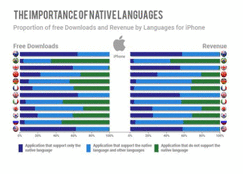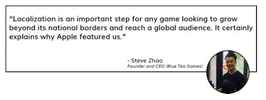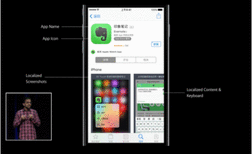Developing an app is a process, but to make it usable by the global audience is a different game altogether. According to GSMA Intelligence , there are already more than 4.8 unique mobile users worldwide, and this number is projected to grow up to 5.7 billion by 2020. Chances are high that your potential app users do not speak your language. A chunk of the mobile users are located in Asia and Pacific regions, and on a global level only around 15% of the users speak English as their first or second language. So, where do these downloads come from?
According to 56.2% global app consumers, the ability to access an app in their native language is more important than the pricing of the app. It’s growing demand is bringing various mobile app development companies to think about it. Therefore, localization has become a vital strategy for any mobile app with a goal to have an increased consumer base.
The mobile economy is booming: over 340k apps are downloaded from app stores every minute. Acquainting yourself with the mobile app localization will therefore give a boost to your revenue chart. If you are reading this, you are probably doing this or considering it. Let’s see how:
Increase your customer base
Some of the well known companies have reached great heights today, due to their app localization game. Let us take the example of Facebook, Twitter, Pokemon Go and Weather channel amongst others who have successfully devised the app localization strategy and this has done wonders to their brand!
Here is an infographic to show the statistics that have contributed to making Mobile App Localization one of the main sources of company’s revenue generation. This should definitely give you some solid reasons to think about the benefits of your app localization.

Access to a constantly growing base of new customers is indeed a valuable asset for your business. With proper localization, mobile apps have considerably lowered the cultural barriers and tend to evoke interest in a varied customer base.
The key to the success of localization of your app also lies in the correct translation of your key content. For businesses that do not have much revenue on disposal for these translations could start by localizing certain elements of the product first page (for example- app name, description, video and screenshots).
Fastrack entry to new markets
Localized app store listing along with a strong app optimization strategy provides an easy and fast access to the global market. App developers could try out by making the app available for multiple countries first in order to test if a particular market is interesting and have a potential value for the growth of the business.
Improvised user engagement and satisfaction
It is true that English is spoken as one of the world’s main languages but many customers would love to see the product content and notifications in their local languages. Localized apps will ensure better experience and understanding of your product. More the users- better for your business.
Variability

Here is a case study on how Defender’s Quest brought about a peak in its sales figure after localizing its app in six languages ie. English, Czech, German, Korean, Japanese and Russian.

Between Android and iOS platforms, there are more than 300 apps and the market is still growing. Every local store is on the lookout of apps that would entice local users. There are a number of success stories based on localization of their app. Blue tea games, the parent of Mavenhall, released their game in various local languages and got features in App’s Store ‘ Best new game’ category in over 120 countries.
Let’s take an example of Evernote. The app put in a little extra effort in localizing their app to suit the Chinese clientele and it paid off generously. They even uploaded customized screenshots of elements in Chinese language, along with changing the description content as well.

However, app developers also have to be very careful in maintaining the cultural integrity - lest it offend customers. For example if the app developers are thinking about launching a beauty app catering to the Middle Eastern clientele, the model images used for the US based clientele will not work in this case and therefore require change.
Increased revenue
Diversifying the apps in various local languages will therefore bring in more revenue and profits as the user base would increase drastically.
How to implement mobile app localization?
- Deciding which language to choose- Figuring out which language your app will be localized in should be your foremost priority. You can do this by simply Google searching the most used language on the internet and finding out which language is used by most paid users of app.
- Deciding which nation to target- Analyze the user acquisition performance report in the stores to find out countries you have not localized to, but are seeing many visits from. These visits can indicate an interest in your application from that country and can be seen as an opportunity to surge installs through localizing.
- Doing ASO of a localized app- Convert your keywords in localized languages, then change the app name, make additional changes like changing the content above the image.
When it comes to implementing changes in the app and localizing it to fit the right market, one has to be very careful, as everything from the format to noun usages - changes! Furthermore, one also needs to pay heed to the country laws which is being targeted for the app launch.
Mobile app localization tools
- Lokalise
- Crowdin
- PhraseApp
Here is a short checklist on mobile app localization:
- Study your target market: make a research to find out the similar apps, navigate at what your competitors are doing, what are your customers’ buying habits in this region and what price they’ll be ready to pay for your product.
- Find out what devices are most used in this locale and what app stores dominate the market.
- Do App Store Optimization for your target stores and find out the best visibility and conversion strategy for this market.
- Prepare and adapt your UI so it can support foreign characters, vertical scripts or RTL languages if needed. Make sure your app supports user-generated text in any languages, independently from the user interface.
- Proof-read the localized content with a native speaker and check the graphics, too – sometimes irrelevant images can fail to transmit the right message to your users.
- Always test your localized app on all devices and platforms to ensure it’s coherent and has no errors or bugs.
The earlier you prepare for it- the more cost effective your app localization process shall be. Appscms provides a simple enough solution for app developers to change their content on their user’s mobile apps without them having to upgrade the app. Hence Appscms will be of use to app developers to experiment with their multiple languages- instantly! All you need to do is just integrate our SDK in your app. Do you know someone who could benefit from our services? Our team is eager to connect with businesses in any industry.
“At Appscms, we make your mobile apps dynamic”








